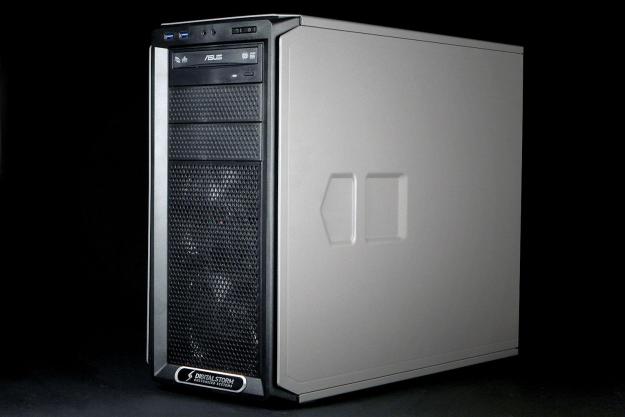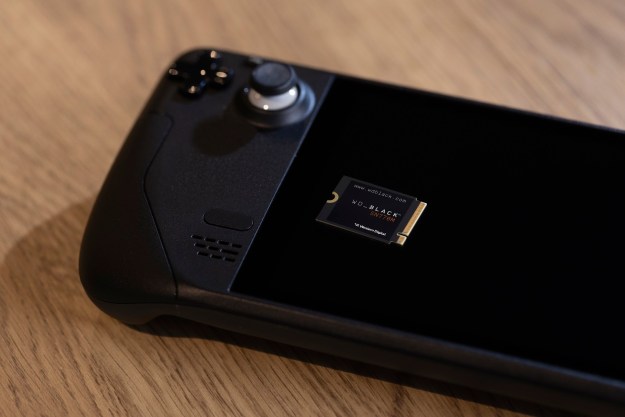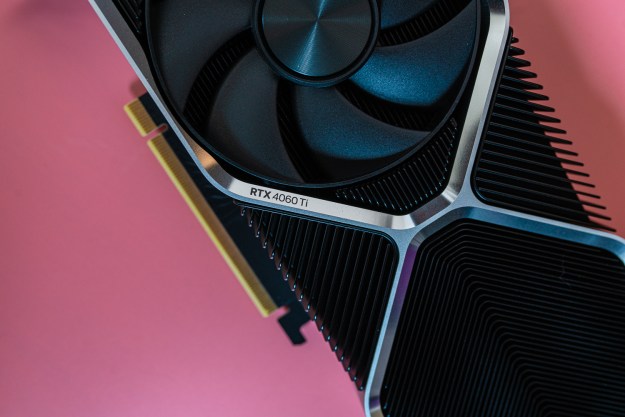
“The Vanquish II is impressively powerful for its $1,259 asking price, but a low-end motherboard limits its internal and external expansion options.”
- Reasonably priced
- Handles 1080p gaming well
- Fast SSD and roomy hard drive
- 3-year warranty
- Very limited expansion options
- Only six USB ports
- Bulging backplate
One of the best things about ordering a custom-built PC from a boutique system builder like Falcon Northwest, Origin PC, or Digital Storm, is being able to choose from a wide variety of components to get exactly the system you want.
Of course, you have to have fairly up-to-date knowledge of the whole swath of the PC component market to make the best choices for your needs and budget. And even when you know exactly what you want and you gather it all together on a system configuration page and click the Buy button, it can often take weeks for a company to assemble, test, package, and ship your customized system.
If your knowledge of PC parts isn’t quite encyclopedic, and you don’t want to wait weeks to unbox your powerful new rig, a system like Digital Storm’s Vanquish II line represents a happy medium. The Vanquish II comes in four different configurations or “levels,” starting at $699 with the Level 1. The system Digital Storm sent us for review is the high-end Level 4.
The Vanquish II Level 4 has almost all of the ingredients to make it a truly great mid-range gaming PC.
By gaming PC standards, the Level 4 is still quite modestly priced, at $1,259. Because Digital Storm can pre-build and test these machines in advance, rather than having to assemble them from a wide variety of parts, the company says any Vanquish II machine you order will be boxed up, pushed out of the loading dock, and on its way to your front door within 72 hours.
So just how well is the Vanquish II Level 4 equipped for gaming and other demanding computing tasks? It’s certainly no slouch, packing a new quad-core (Haswell Refresh) Core i5-4590 CPU with a base clock of 3.3GHz, 8GB of RAM (plenty for gaming and most anything else, unless you’re often working with huge files), and both a roomy 1TB hard drive for storage, and a 120GB Samsung SSD for fast boot times and quick game level loads. The Level 4’s gaming prowess comes via its Nvidia GTX 770—a graphics card that’s plenty capable of delivering smooth frame rates at high settings in today’s games up to a resolution of 1080p.
The Level 4’s configuration does have its downsides though, which primarily come thanks to its Micro ATX Asus motherboard. This choice of mobo limits the amount of extra drives and expansion cards you can add to the system. It also offers only six USB ports, although four of those ports are of the faster 3.0 variety.
As mentioned, we think the Vanquish II Level 4 is reasonably priced. A spot check of the current prices for the system’s parts adds up to right around $1,000. As usual, it’s cheaper to build your own system. But that takes time, especially to construct a clean build, as Digital Storm has done.
Also, if you build your own PC and run into a hardware issue, you’ll have to diagnose the offending component yourself, and deal with whatever warranty and service comes with that part. The Vanquish II comes with lifetime customer service, and a 3-year limited warranty. By comparison, similarly priced HP systems ship with two years of coverage, and Dell desktops are covered for just a year.
A solid, roomy case, but nothing special
Digital Storm builds the Vanquish II inside a “Battleship Gray” Corsair Graphite Series 230T mid-tower case. The steel sides and top feel solid, and a pair of blue intake fans in the front add some visual flair. It’s nothing as flashy as, say, Origin’s high-end Millennium tower, but the Vanquish II is certainly more visually interesting than most desktops you’ll find in big-box stores.
Popping off the side of the case is accomplished by removing a thumb screw from the back and pulling the door forward. While this is a midtower chassis, there’s lots of room for expansion. The Samsung 840 Evo SSD and Seagate 1TB hard drive are surrounded by three empty 2.5-inch (SSD) bays, and three spare 3.5-inch (hard drive) bays. There are also a pair of vacant external 5.25-inch bays in the front, below the USB ports, audio jacks, and the vanilla DVD drive.
A Micro ATX motherboard means limited expansion
So, the Level 4’s case has room for a total of eight extra drives. But before you work up any ambitions about turning this system into a storage monster, note that the Asus H81M-D PLUS motherboard only has four SATA ports for connecting extra drives—and three of those are already occupied by the DVD drive, SSD, and hard drive.

Likewise, because the motherboard is Micro ATX, rather than a full-size ATX board, card expansion is quite limited as well. There are technically two empty PCI Express x1 slots on the board, but one is blocked by the
The external port selection is also quite limited. On the back of the Vanquish II Level 4, there are just four USB ports (two 2.0 and two 3.0). If you’re holding on to an old keyboard or mouse, you may appreciate that there are two PS/2 ports here. The Gigabit LAN port should deliver solid Internet and network connectivity (there’s no Wi-Fi here).
The real oddity on the back of the system is the motherboard’s inclusion of a Parallel Port. It has been years since we’ve seen a desktop with this port, and it’s not likely to be of much use to gamers. There are certainly plenty of high-end printers and other older (but still expensive) professional printers around that connect via Parallel Ports. But for modern gamers and general PC users, the space taken up by this large port could be put to much better use by adding more USB ports.
Also, while Digital Storm mostly did a good job assembling our review unit, they fumbled when installing the metal I/O port cover. All the ports on the back are still accessible, but the metal plate bulged out noticeably away from the ports. It’s a purely aesthetic mistake, which could be fixed by removing the motherboard (not an easy task, but doable if you have the know-how and patience).
We should also say that this is likely a fluke, rather than something that often happens with Digital Storm’s system builds. But it detracts from the professional feel of the build, and if we paid over $1,200 for a gaming PC, we’d be annoyed if the system arrived with a bulging backplate.
Configuration considerations
As we said up top, the Vanquish II is available in four configurations. All sport the same Asus H81 chipset motherboard, so our main complaints about a lack of upgrade options and the limited number of USB ports will apply to all models. And they all sport the same Corsair case, 8GB of
The $699 Level 1 option will get you a Core i3 CPU, a mid-range Nvidia GTX 750
The Level 3 bumps the CPU up to the same Core i5-4590 that’s in our Level 4 configuration, and drops in a GTX 760 card, plus a more ample 600-watt power supply. This model should handle games at 1080p with most settings set to high. However, you won’t get the SSD found in the $1,279 Level 4, which will deliver much faster boot times and game loads. The Level 4 also has a GTX 770 card, providing some extra oomph to get your games going at max settings, and also gives you a little more performance overhead so tomorrow’s games will be playable longer before you need to upgrade.

If your budget is tight and you don’t care about running games at max settings, the $779 Level II should serve you fairly well. But considering how low the prices of SSDs have dipped lately, and how much faster solid-state drives make a system feel, we’d really like to see Digital Storm add an SSD to at least the Level 3 build, if not the level 2.
In a recent build story, we were able to add an SSD to a system with a $350 budget, so boutique builders should be able to do so in systems that cost more than twice as much. To be fair though, our budget build lacked a dedicated
Good all-around performance
The new Core i5-4590 CPU in the Vanquish Level 4 (and Level 3) is no benchmark breaker, but it does have four cores, and a swift variable clock speed between 3.3GHz and 3.7GHz. In our SiSoft Sandra Processor Arithmetic test, the Level 4 scored a respectable 80.8 GOPS. That’s a far cry from the 222.92 GOPS scored by the six-core 2014 Origin Millennium, but the Origin machine is priced at nearly $7,000.

And the price difference between those two systems doesn’t stop after you click the Buy button. The Millennium, with its six-core CPU and three GTX 780 Ti graphics cards, drew 168 watts at idle, and a circuit-taxing 1,023 watts under load. By comparison, the Digital Storm system drew just 62 watts at idle and 102 watts under load. That’s right, under load, the high-end Origin system uses over ten times the power as the Level 4 we’re looking at here. The high price of extreme gaming isn’t all down to component costs.
But unless you’re often editing HD (or even 4K) video, or doing other tasks that lean heavily on the processor for long amounts of time, or you’re otherwise often editing huge files, the Core i5 CPU, SSD, and 8GB of
7-Zip’s file compression test saw the Vangquish II’s four-core processor do pretty well, scoring 15,841. But the Millennium’s six-core CPU stomped all over the lesser Vanquish machine, turning in a result of 38,704.
PCMark 8’s storage test turned in a score of 4,974, which isn’t far behind the Millennium’s 5,019. Both systems have a single SSD, but instead of an SSD and and a 1TB drive, the Millennium’s Samsung drive is a spacious 1TB all by itself.

The Vanquish II’s single GTX 770 is no match for the Millenium’s trio of high-end 780 Tis, though. The Digital Storm’s 3DMark Cloud Gate score (16,766) and Fire Strike (6,685) are more than respectable. But the Origin Millennium’s score of 39,759 in Cloud Gate crushes everything else we’ve tested to date—as it should, given that configuration’s nearly $7,000 price. But Fire Strike doesn’t properly support three graphics cards (just like many games), so the Millennium’s score on Fire Strike is still better, but isn’t as impressive, at 8,957.
Good enough for 1080p gaming at high settings
The Asus Direct CU GTX 770 Ti
Also, even when gaming or maxing out the CPU, our sound meter never registered the system above the background noise of our office—although with the air conditioning on and World Cup fever in full swing among some of our co-workers, our office was pretty loud when we were testing, hovering around 58 dB.
Total War: Rome 2
At medium detail, the Level 4 produced an average of 65 frames per second, with a minimum of 49 and a maximum of 85. At extreme detail, its highest setting, the game still managed a solid average of 48 FPS, with a minimum of 33 and a maximum of 64. That’s well behind the likes of much pricier machines like Origin’s Millennium, but still plenty playable, without ever dipping into choppy territory.

Battlefield 4
With Battlefield 4 set to medium detail, the Level 4 ran at its average framerate of 143 FPS for the duration of our testing. Setting detail to ultra produced an average of 67 FPS, with a minimum of 57 and a maximum of 100. Again, unless you’re a framerate purest who never wants to see anything below 60 frames per second, the Level 4 should serve you well when gaming at 1080p.
League of Legends
The Vanquish II Level 4 had no trouble with our least demanding game. At medium detail, it reached an average of 185 FPS, with a minimum of 128 and a maximum of 248. Increasing detail to very high reduced the average to 147 FPS, with a minimum of 89 and a maximum of 205. Unless you plan on gaming with multiple screens, or you’re aiming at playing games at
Conclusion
With a reasonable price, good gaming performance at 1080p, quick shipping, a three-year warranty, and a mostly solid selection of components, the Vanquish II Level 4 has almost all of the ingredients to make it a truly great mid-range gaming PC.
However, the system’s H81 motherboard is the Achilles heel that really holds it back. If you’re sure you don’t need more than four rear USB ports (or you’re fine with using a hub), and you aren’t the type to upgrade and add your own drives or other components, then this system should serve you well—especially if, for some reason, you also require a Parallel Port, which this system’s motherboard has.
But expandability and upgrade-ability are two of the key value points of a custom-built PC. And Digital Storm’s choice of motherboard with the Vanquish II line limits the options on that front quite a bit, while also delivering fewer USB ports than we’ve seen on a gaming desktop in quite a while.
There are much more feature-rich motherboards available that support Intel’s current chips, and many are available for less than $50 more than the Asus model Digital Storm chose here. We’d like the Vanquish II a lot better if Digital Storm had chosen one of these slightly more expensive boards with more SATA and USB ports, and more expansion slots—even if they passed the extra cost directly on to the consumer.
Highs
- Reasonably priced
- Handles 1080p gaming well
- Fast SSD and roomy hard drive
- 3-year warranty
Lows
- Very limited expansion options
- Only six USB ports
- Bulging backplate
Editors' Recommendations
- 9 best processors for PC gaming: tested and reviewed
- I’ve reviewed every AMD and Nvidia GPU this generation — here’s how the two companies stack up
- The 6 best places to buy a prebuilt gaming PC in 2024
- The 6 best PC cases in 2024
- How to buy a gaming PC for the best performance and value












